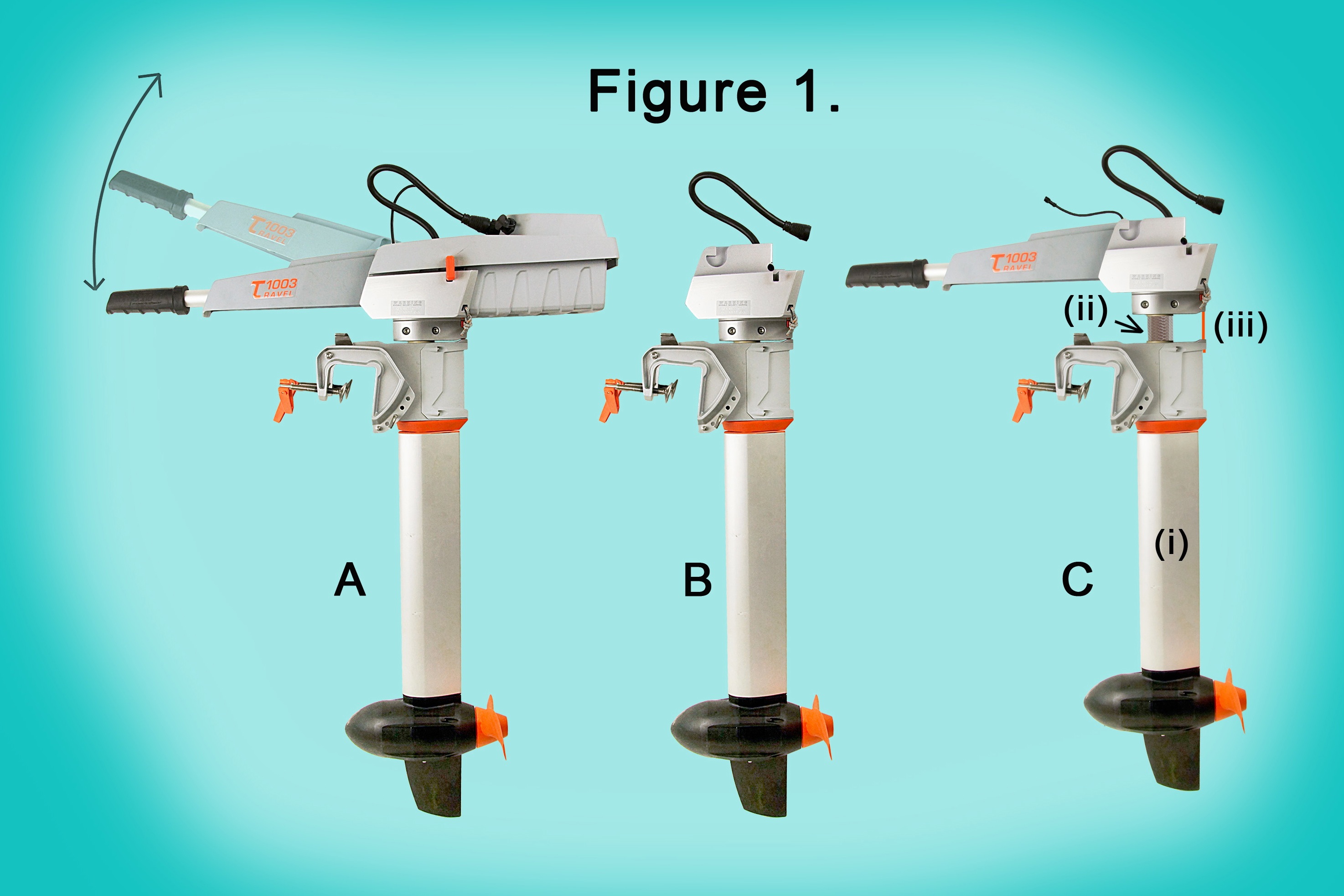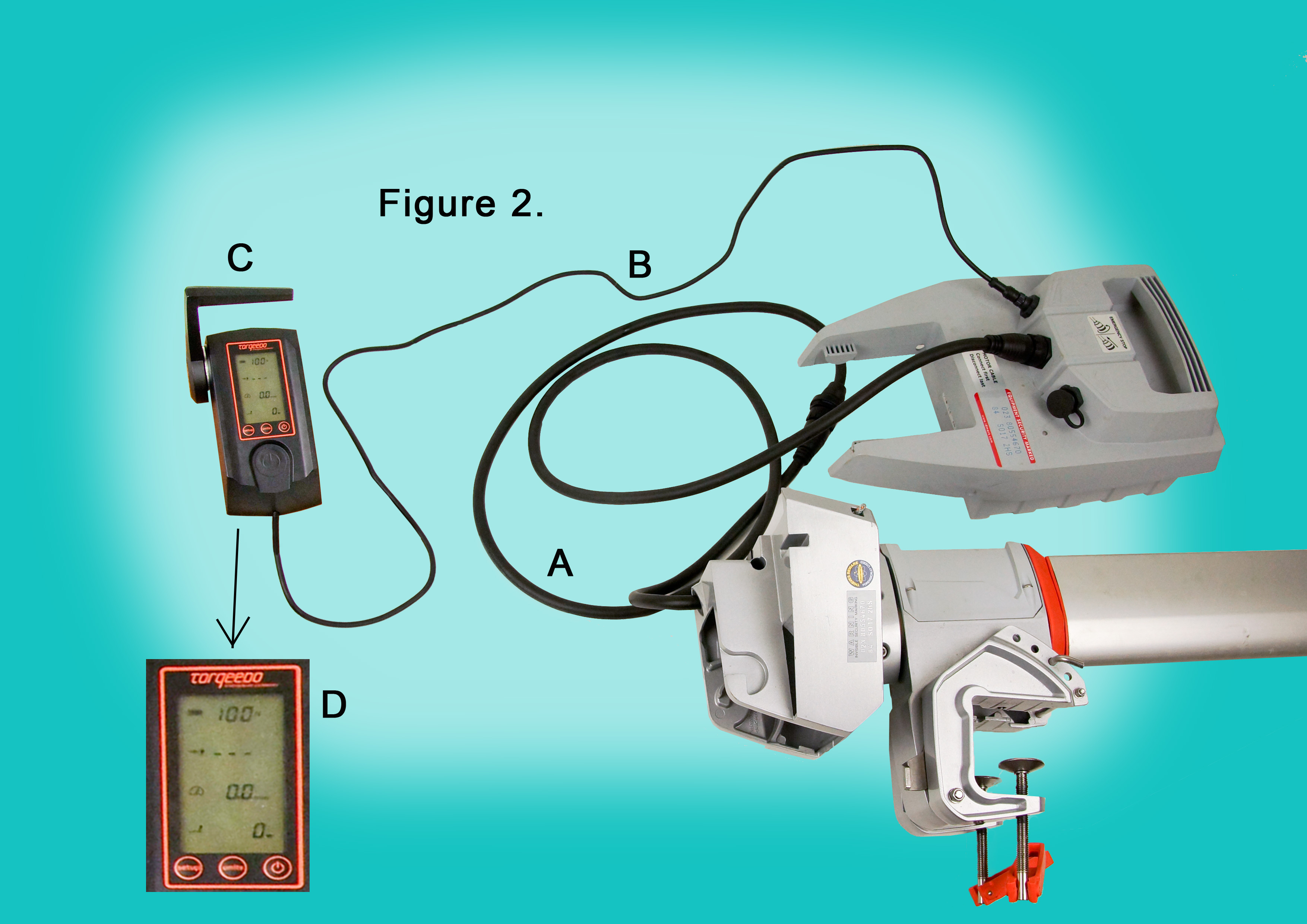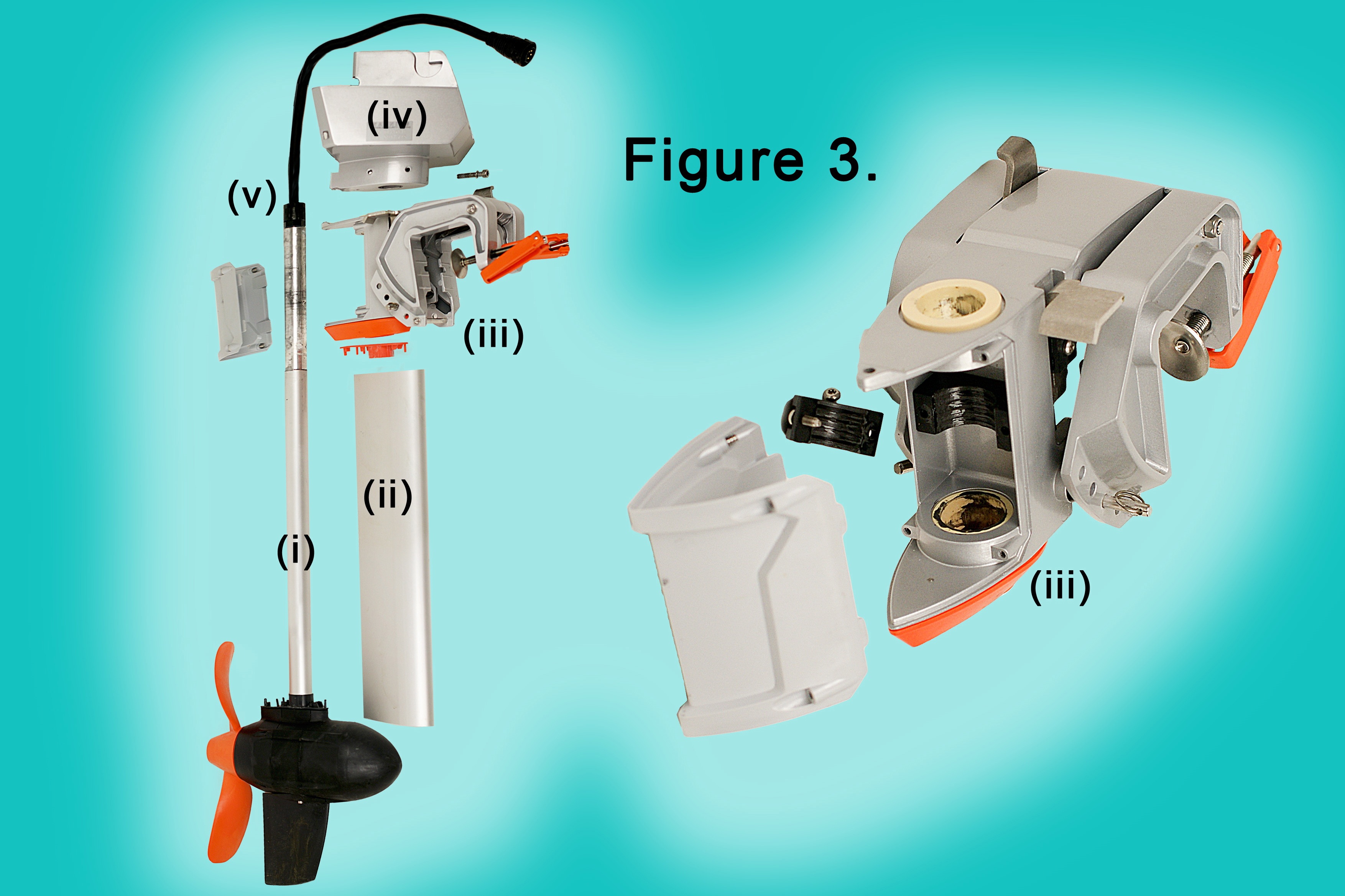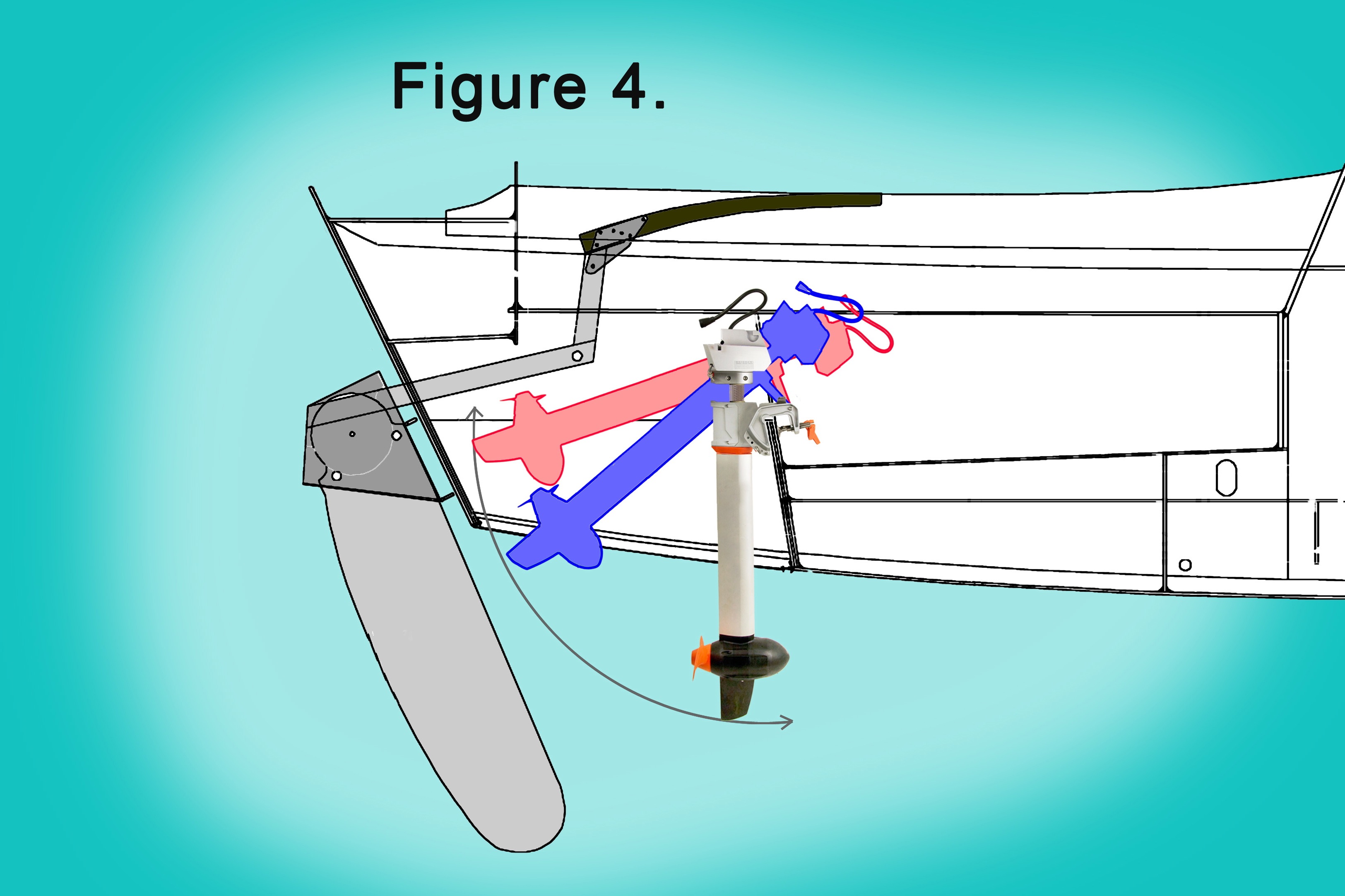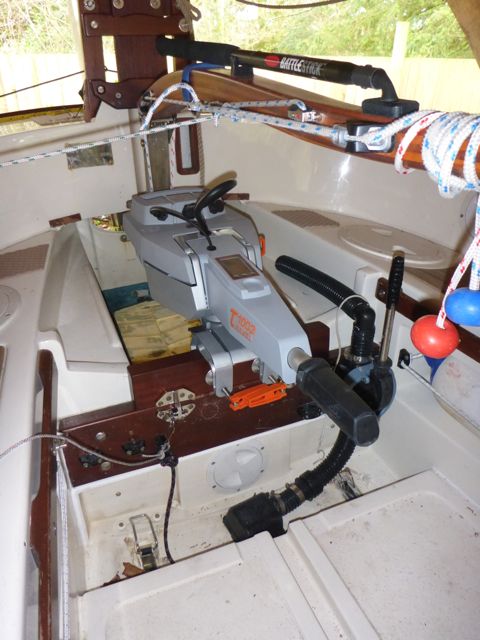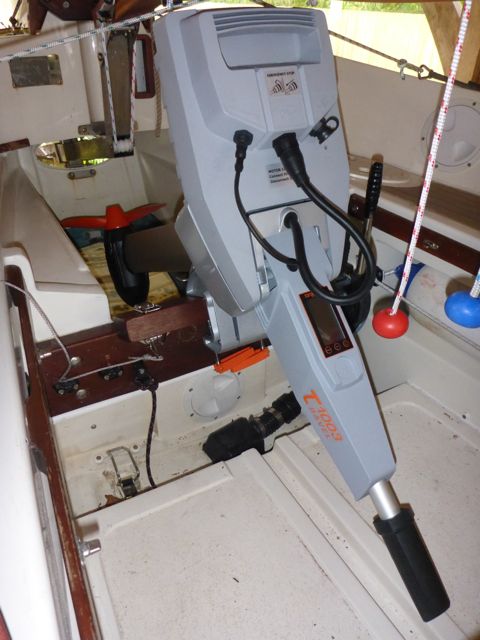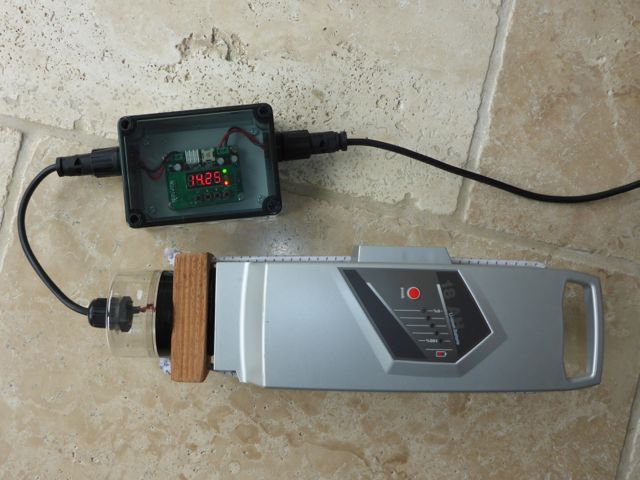Introduction: The advantages of electric outboard motors include pollution free operation, relatively light weight, and low noise*. Unfortunately, cheap trolling motors (e.g. Minn Kota) are low in power while more powerful electric OBs ( e.g. AquaWatt), are very expensive. Claimed to be equivalent to 3 to 4hp the Torqeedo Travel 1003S would seem the best compromise in terms of power and cost (the Torqeedo can be bought for around £1,450 -2014 RRP – discounts can be found). However noting the caveats with regard to available power and range discussed below, one of the larger types of 12v trolling motors might be worth consideration. The following notes have been revised (June 2014) based on experience in modifying and using a 1003S on a BayCruiser 20.
* Although the Torqeedo is very quiet compared to a petrol outboard it is not silent. It is noisier than a typical trolling motor, and produces a whine from the motor unit which some people find annoying.
1. Installation Issues
Although light in weight the Torqeedo is not compact and, being a different shape from petrol outboards won’t fit into an SB outboard well. Even for the “short shaft” 1003S (see “A” in Figure 1) the shaft is too long to allow the outboard to be tilted and the battery pack, sticking out at the back, will foul the rudderstock/tiller assembly.
1.1 Remote Battery and Throttle: A 2m motor-battery extension cable (£29 – “A” in Figure 2) and either 1.5m (B) or 5m tiller extension cables (each £19) are available. These allow the motor to be tiller operated with battery removed (as in Figure 1B & C).
Alternatively purchasing a remote throttle unit (Figure 2C – £169 including both 1.5m and 5m throttle extension cables and a spare kill-cord) allows the motor to be controlled from further forward in the boat with the motor locked in direction and the boat steered with its own rudder. The electronic display on the remote throttle (D) shows the same information as on the tiller: the power being drawn from the battery, the percent charge left (and how long this will last at present speed), and the speed over ground from a GPS unit in the battery. Having this information in view is important for using the motor most efficiently. An implication is that if removed from the motor, the battery needs to be positioned where the GPS receiver will still work; no problem was encountered with the battery in the closed BC20 cockpit locker.
1.2 Shortening the Shaft: Figure 3 shows the shaft assembly. A stainless tube (i) is sealed into the motor pod and surrounded by an alloy fairing (ii), the two being kept apart (to avoid corrosion) by plastic end plates. The tube passes through two nylon bush bearings and a central friction bearing visible in the larger view of the transom bracket (iii) above which it is clamped in the shaft head unit (iv). A cable gland at the tube top (v) prevents water ingress to the motor.
The shaft can be shortened without compromising the water resistance by sliding the tube it up in the transom bracket. This is illustrated in Figure 1C. Depending on what SB model you have around 5cm may be all that is required. It will be necessary to cut the fairing (i) to length, insert some form of spacer between the transom bracket and the shaft top (ii) and improvise a lengthened pin (iii) if the steering is to be fixed. Since the top section of the stainless shaft is milled (see Figure 3), it may be necessary to ease the lower bush bearing slightly using a file.
Figure 4 (below) illustrates how the shortened motor will fit in a BC20. One advantage is the small amount of cockpit space occupied. A disadvantage is that the large propeller tends to jam across the outboard well opening and, being plastic, the propeller edges are easily damaged leading to a loss of efficiency.
2. Power and Range
2.1 Available Power: At full power the 1003S consumes 1000W and will push theBC20 along at a little over 4 kts in calm conditions. However the battery is only rated at 520Wh so will be depleted in around half an hour. In other words you only have the claimed 3 to 4 hp available for a very short period of time. The motor is much more efficient at half throttle or less. For the BC20, maintaining 2kt only requires around 200W so 3 hours or more is possible.
These performance figures are in line with those claimed by Torqeedo. In practice the available power is severely limiting. If motoring against currents or wind, use of higher power levels for even a short time limits the distance you can travel. In strong winds the Torqeedo struggles to drive a BC20, quickly depleting the battery. Thus while the Torqeedo is adequate for auxiliary use in picking up or leaving moorings and motoring on lakes or when becalmed, extended motoring in against strong winds, currents, or waves is not a viable option.
2.2 Extending range: Buying a spare battery is expensive (£500) and the maximum capacity of Lithium ion batteries continually decreases with age even if they are not used (Torqeedo specify about 4% per year, more if kept fully charged in hot climates). The battery can be charged underway using a solar panel, that sold by Torqeedo costs £900.
A less expensive strategy is to connect a 12v power source (e.g. a lead acid leisure battery) directly to the Torqeedo battery charging socket while the motor is in use. It is not necessary to convert to mains AC voltage using an inverter as variously stated in Torqeedo literature. The Torqeedo battery charging circuits will draw roughly 30W (about 2.5A) which can be used to help power the motor. For example, if the displayed power consumption is 230W before the 12V source is attached, it will reduce to 200W, and the indicated remaining range for the Torqeedo battery will increase proportionally. A connecting cable and charging plug of similar size to that provided on the Torqeedo mains charger is adequate. A 4A fuse should be used to protect the cable and limit current to the battery.
At slow speeds or when sailing the excess power is used to charge the Torqeedo battery. This means that if you use, say, a third of the capacity of the Torqeedo battery (175Wh) when motoring off moorings in the morning, after 6 hours sailing it will be fully recharged ready to take you back in the evening. If the 12V comes from a 100Ah (1200Wh) battery there will be ample spare capacity for running the electronics. This was found to work well for low to moderate use of the Torqeedo (a 2 mile motor down a river at around 2 knots before setting sail for the day). However note that if the lithium battery is very low in charge, the power drawn from the 12V source will still be only 30W – not enough to power the motor at any speed. Options for faster recharging of the Torqeedo battery are discussed in an addendum below.
Weight Considerations: This is a big advantage of the Torqeedo. The part of the 1003S to be mounted on the OB bracket weights 8.9kg which makes mounting and removing it easy – a 4hp petrol outboard is typically 3 times heavier. The Torqeedo battery weighs 4.5kg and a 100Ah leisure battery about 21kg. In total, the motor and two batteries would weigh 34kg – about the same as a 4hp petrol OB with separate 12 litre tank, one with a 1.5l integral tank is 7kg less. However with the petrol OB you would still need a battery for any electronics. If the leisure battery is sited below the cockpit deck, most of the weight is further forward and lower in the boat compared to a petrol OB. The Torqeedo is easy to transfer to an inflatable while afloat and if accidentally dunked in the water during the process it will suffer no damage.
3. Caveats in the User Manual
You have to put up with various operating instructions which effectively transfer responsibility from Torqeedo to the user.
3.1 “Only charge the battery on non-inflammable ground” which is a problem for charging it on a boat underway! Fires in lithium-ion batteries are extremely rare but have been known to occur. Torqeedo stress that redundant safety measures are used in the integral Battery Management System and say there have not been any problems with their own units.
What if something did go wrong? Torqeedo suggest covering the battery with sand which is OK if you happen to be on the beach! However, according to the Lithium Battery Safety and Handling Guideline (WHOI, 2006), fires in rechargeable lithium-ion cells do not involve metallic lithium and can therefore be fought using an ABC dry chemical extinguisher. It is also permissible to immerse a lithium-ion battery in water to limit, if not extinguish, the fire (this would cause an explosion if done with a non-rechargeable lithium primary cell). Although the risk is extremely low, given the potentially grave consequences of a fire on a SB it might be prudent to position the Torqeedo battery in a position where it could be rapidly dumped overboard. Also it is good practice with any lithium-ion battery to disconnect the charging cable once the battery is fully charged. If kept in the cockpit locker, fitting a smoke alarm there seems a sensible precaution.
3.2 “Do not leave the motor in the water when the boat is moved by other drives (e.g. while sailing, towing the boat) to prevent damage to the electronics”. Taken literally this restriction would make the motor next to useless! I’ve been assured by a Torqeedo dealer that “in a real life situation it is highly unlikely that the propeller will be driven by water up to such a speed that the motor would be turned into a generator”. However I have noted the propeller start to turn when getting away under sail and I’ve quickly raised the outboard as a precaution. This means keeping the motor deployed “just in case” may be risky.
3.3 “Except when charging the charging socket must always be covered”. I’m told that this is because while the non-covered socket is waterproof it doesn’t comply with the “foreign object” requirements of IP67 so a rubber cap is provided to prevent any accidental shorting.
3.4 “After operation in salty or brackish water, wash all components in fresh water.” It is hard to understand what you are meant to wash! However one problem experienced after a year or more use in salt water was corrosion of the thrust washers which then caused failure of the shear pin and loss of drive to the propeller. To wash these parts would mean removing the propeller after every trip. Regular inspection and replacement would seem a worthwhile precaution.
3.5 “the product was in any way altered…” …of course, shortening the shaft as suggested here will void the warranty, you do so at your own risk!
4. Useful spare parts
The following are available from Seamark-Nunn (and presumably elsewhere).
4.1 Kill-cord. the Torqeedo one is non-standard and consists of a magnet in plastic casing (Figure 5A). Experience has shown that the magnet can corrode causing the casing to come apart (Figure 5B) and the magnet fall out and be lost! In any case there should be a spare kill-cord on any boat so that, should the helmsman fall overboard, those remaining onboard can restart the engine and return safely to the pub. A spare costs £20 (!), or there’s one included with the remote throttle unit. Any small, strong magnet should work, but try it out on land first.
4.2 Propeller shear pin (£2) or, for the accident prone, a kit which includes two pins, washers, and that vital nut which holds the propeller on (£7-50)! You also need to carry a size 17 socket spanner to remove the propeller.
Reference: Lithium Battery Safety and Handling Guideline, Woods Hole Oceanographic Institution, 2006 [ http://ehs.whoi.edu/ehs/occsafety/LithiumBatterySafetyGuideSG10.pdf ]
5. Summary Although originally keen to use an electric outboard on my BC20 which I sail in the Solent, the Torqeedo proved too restricting; the usable power was not adequate for stronger wind conditions, or with waves or currents. I suspect the Torqeedo would be OK on a BR20 in calm conditions and for the Bayraider Expedition or BC20 on inland waters for limited distances. On my BC20 I now use a 6hp Tohatsu, and I use the Torqeedo on my 15 foot sailing dinghy for which it was originally bought and where it is very capable. If I was starting again with electric I would investigate the capabilities of the more powerful 12V trolling motors that are becoming available. Peter Taylor.
Addendum 1 – Mounting the Torqeedo in a BR20
It is possible to mount the Torqeedo without modification in a BR20 by installing a transom height extender secured by hatch hinges. To match the existing transom, use some 38mm Sapele wood, 400mm wide and 75mm high, stained with Sikkens Cetol Filter 7-Plus Mahogany.
To tilt the motor, simply tilt the whole transom extension forward on its hinges (not using the motor tilt mechanism) and the Torqeedo propeller clears the back of the well opening – just! It is usually necessary to fish around with the position of the propeller (one blade straight up, the other down) to slide it up through the lamellae but otherwise it works well. Apparently a long wooden salad fork can assist with this process. The arms of the hatch hinges move the motor forward when it is tilted – using normal hinges would necessitate a higher transom extension. An eccentric latch on the back of the extension secures it in the upright position to the transom, so that the motor can be used in reverse without kicking the propeller up.
The motor’s battery can be kept in place when tilted, as the back clears the underside of the tiller even when in the straight ahead position – but only just. The back of the battery easily clears the rudder stock when the motor is untilted. Always remove the motor’s kill switch when tilting the motor and especially when fishing around trying to align the propeller through the lamellae.
Because the hatch hinges can be taken apart, it is possible to demount the extension and revert to a normal transom for use with a petrol outboard.
Addendum 2 – Overcoming range anxiety
As with electric cars, range can be a bit of a problem with the Torqeedo. At full throttle (which achieves 5 knots on a BR20), the Torqeedo battery will be fully depleted in less than 30 minutes, whereas at 3 knots, it can keep going for over two hours. Sadly, there is no efficient substitute for having a spare lithium battery but if you find the cost (currently about GB£450) offputting, and as already mentioned by Peter above, it is possible to charge the Torqeedo using your boat’s 12v battery – if it has the capacity.
Here is a variety of non-mains charging options that have been found to work:
1. 12v battery plugged directly in to the Torqeedo with a diode and a 4A fuse. Assuming that your boat battery is large enough, this would take about 27 hours to fully charge from empty. By contrast, the standard mains charger takes about 13 hours while the yet to be released fast mains charger should take about half that time. The 12v route could be combined with a decent-sized solar panel charging the house battery so that in due course and assuming sufficient sunshine, even a small 12v battery ought to be capable of fully recharging the Torqeedo. However, it would probably take several days to do so.
2. 12v battery routed through a step-up converter to provide a charge of around 34v, with a maximum of 4A and fused to prevent the current rising any higher than this. Waterproof step-up converters with a fixed 32v 3.4A conversion are available. Non-waterproof circuit board converters are also available. These have an LED display to show input and output voltages and with the ability to adjust output. The waterproof converter gives the higher charge, particularly when the Torqeedo is already in use. As such and provided that the motor is being run at only moderate revs, this may be the best option for on-the-go range extension. For example, at 4 knots, the unboosted range is less than 5nm but could be extended to 6nm, or even to 7.5nm if a two hour break for lunch is taken in the middle. There are, however, a couple of caveats: the converter generates a lot of heat and tends to cut out; and avoid running the load through a solar controller, which may not be able to cope with the current without frying its circuits.
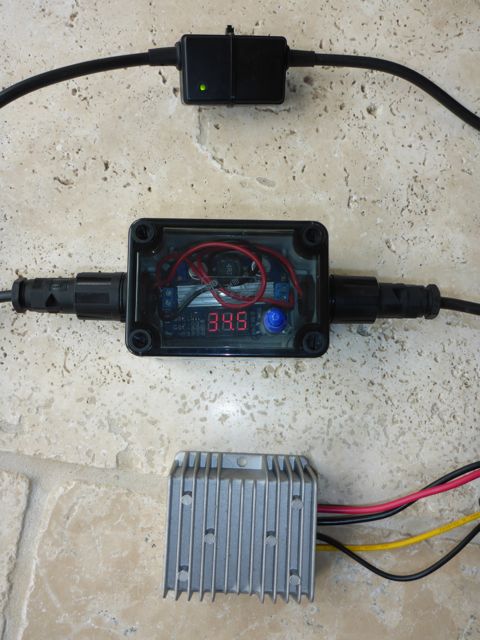
From the top: 12v trickle charger, 12v adjustable step-up controller (in waterproof enclosure), waterproof fixed voltage step-up controller
3. Torqeedo flexible solar panel plugged directly in to the Torqeedo. In standard European sunshine, this is claimed to take 13 hours to fully recharge the battery. The current cost of GB£800 for the panel probably makes a spare battery a more attractive proposition.
4. Higher capacity lithium batteries through a step-down controller to provide a charge at 12v. For example, the latest 28v batteries used to power electrically-assisted bicycles have nearly enough capacity to recharge the Torqeedo in one go, albeit fairly slowly (around 20 hours). Unfortunately, they are not usable at higher voltages due to a phenomenon known as inrush current, which blows the 4A fuse. An electrical engineer could devise a soft-start circuit board to overcome this problem but there does not appear to be anything available off the shelf.
To put this in perspective, a Suzuki 2.5hp’s tiny integral fuel tank gives twice the range of the Torqeedo at 5 knots and can be refuelled many times from a small jerry can. If you operate somewhere where petrol outboards are banned and as long as you are not combatting strong winds and currents, the Torqeedo is a viable albeit expensive alternative. Especially on a boat where the primary means of propulsion is always going to be sail.
Graham W April 2014

